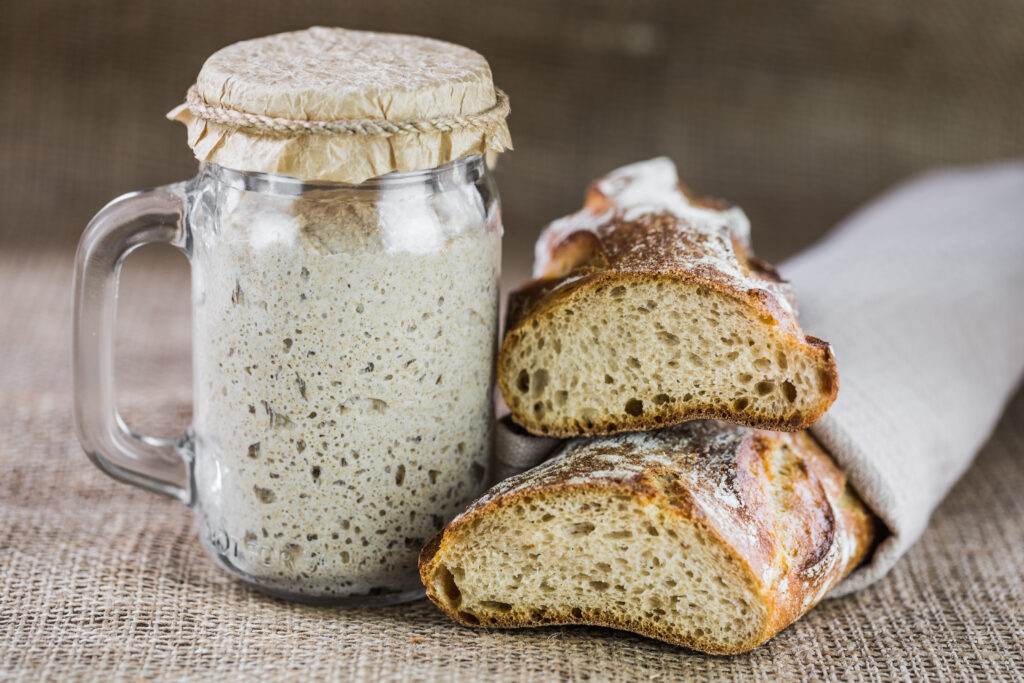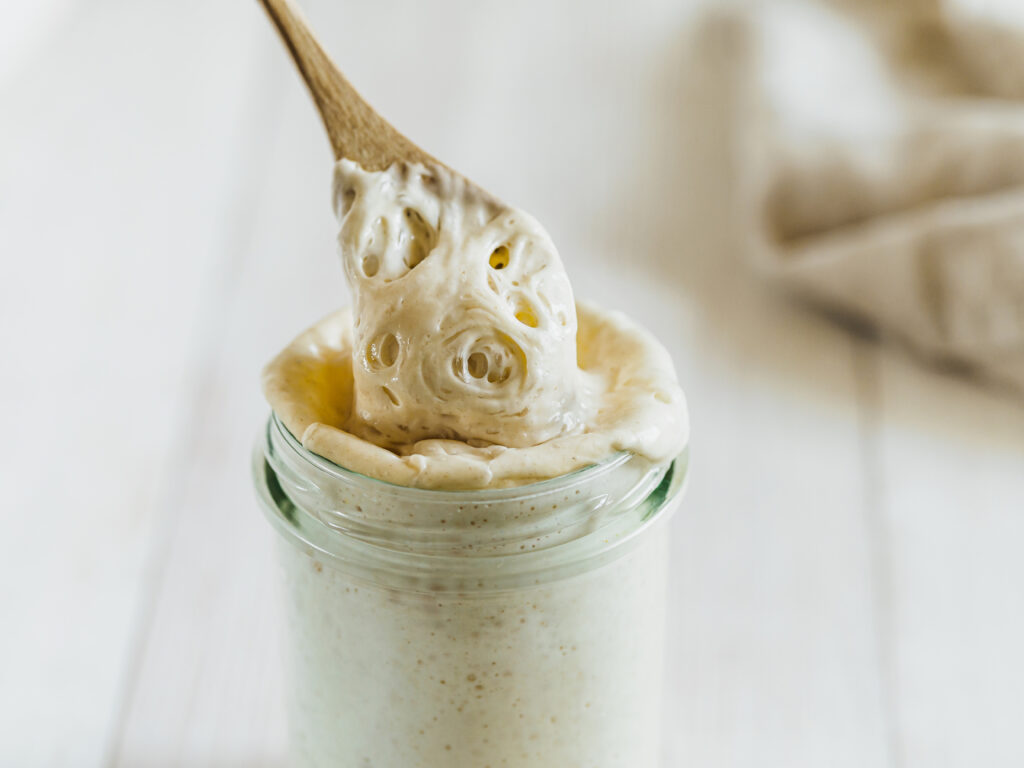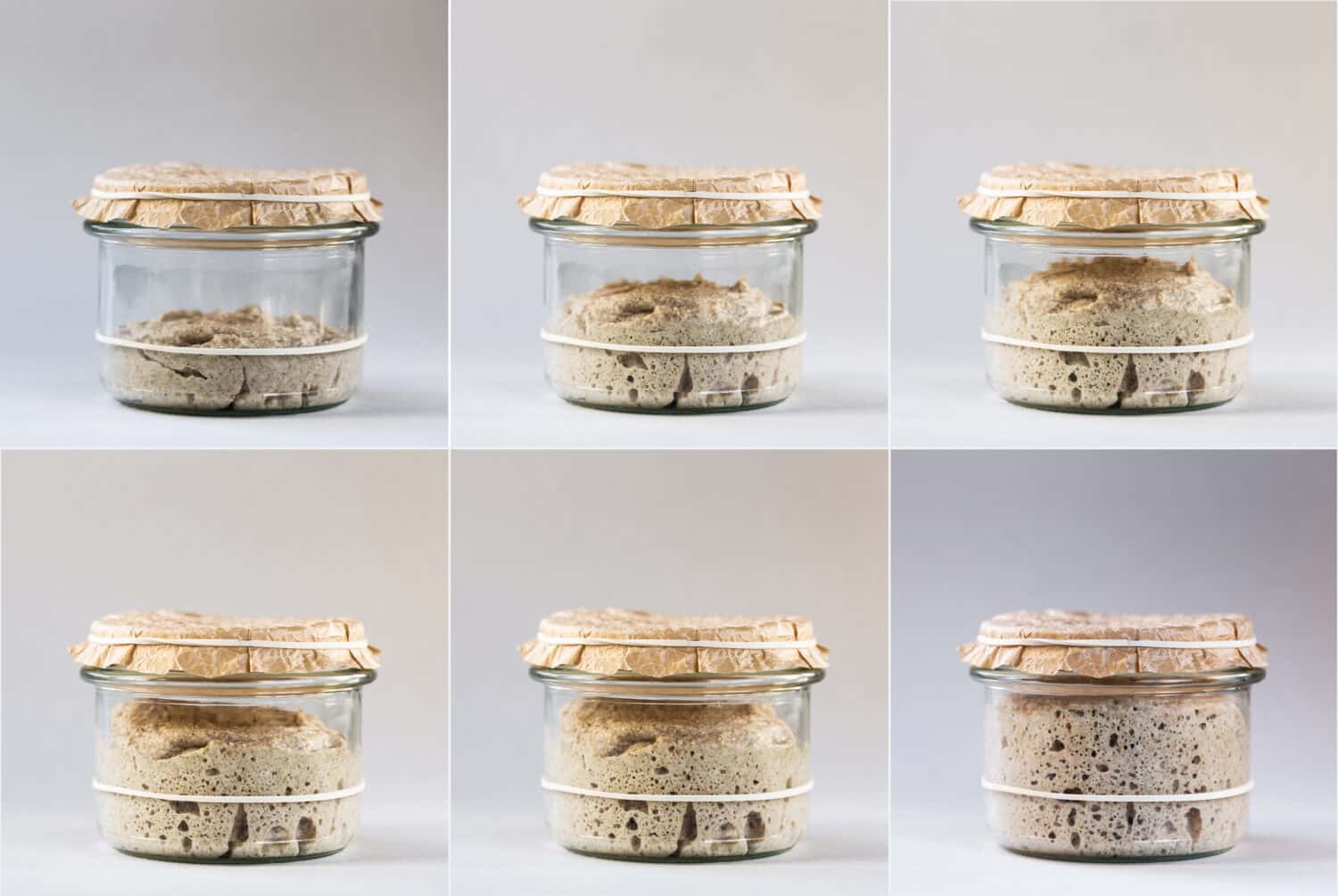Leavening is a transformation process that occurs due to fermentation. This process has occurred for over 5000 years, and sourdough starters are the oldest leavening agent available. What is the oldest sourdough starter still in use today? Keep reading to find out!
What Is A Sourdough Starter?

What is the oldest sourdough starter still in use today? Keep reading to find out!
©Zagorulko Inka/Shutterstock.com
Sourdough starters are live colonies requiring feedings, watering, and consistent temperatures. Sourdough starters (also called mothers) work by mixing flour with water. Wild yeast and bacteria will then colonize the mix. When water blends into flour, it’s exposed to air so bacteria and yeast in the environment can set up shop in the slurry.
The bacteria and yeast consume the carbohydrates from the flour. The yeast’s byproduct is carbon dioxide, forming the bubbles seen in sourdough bread. The bacteria create lactic acid, making sourdough’s characteristic sourness.
It needs proper care to keep a starter alive for a century or more. The type of carbohydrate used needs to remain the same, water levels need to be consistent, and regular feedings need to be on time.
What Is The Oldest Sourdough Starter Still In Use Today?

Sourdough bread is easier to digest, contains prebiotics encouraging healthy gut bacteria, is calorie dense, and contains less glucose than regular bread.
©Fascinadora/Shutterstock.com
The oldest sourdough starter still in use today is at Boudin Bakery in San Francisco, California. Its sourdough starter dates back to 1849. The Boudin Bakery began that year using a starter obtained from gold miners that rushed to the area the year before.
During the California Gold Rush of the 1850s, sourdough starters were prized commodities. Food was scarce, and flour was an everyday staple most miners had. Having access to a sourdough starter enlivened their bread and provided a taste profile to their diets that became prized.
Sourdough bread is also more nutritious than unleavened bread. That’s because it’s easier to digest, contains prebiotics encouraging healthy gut bacteria, is calorie dense, and contains less glucose than regular bread.
Determining a sourdough starter’s age is extremely difficult, leaving the age of most living sourdough starters up to conjecture. Since the residing ingredients in the starter consume all of the added flour, the grain cannot accurately be dated.
The bacteria and the yeast reproduce and die quickly, so they do not give away a starter’s age. None of the microorganisms live for more than 14 days.
Who Invented The First Sourdough Starter?
No one is sure who invented the first sourdough starter though the earliest evidence of breadmaking is from Africa. The Ancient Egyptians probably used a starter in their food around 4000 years ago.
It’s believed that part of the previous day’s bread dough was saved in Egypt and added to the next day’s batch, effectively transferring the starter daily. This process is known as backslopping.
The Romans made the first provable sourdough, as mentioned by Pliny, the Elder, around 77 CE. The Romans also practiced backslopping as a means of transferring the colony daily. The New Testament of the Christian bible was written at roughly the same time and also mentioned backslopping in the leavening process.
Where To Find tThe Oldest Sourdough Starters Still In Use Today

Determining a sourdough starter’s age is extremely difficult, leaving the age of most living sourdough starters up to conjecture.
©Bukhta Yurii/Shutterstock.com
Since there is no way to carbon date a sourdough starter, we can only date a mother’s age anecdotally or by supporting documentation. Some businesses still use some of the oldest starters alive today. The Puratos Sourdough Library in Belgium is devoted to preserving some of the oldest sourdough starters in the world.
Some listings on common online marketplaces advertise starters from the Middle Ages. There are a lot of hoaxes online claiming that their starter is centuries old. This is highly unlikely as these claims are based on shaky stories and family legends.
| Name of Starter Owner | Age of Sourdough Starter | Where to Consume |
|---|---|---|
| Daniel Giraudo | 174 Years Old | Boudin Bakery in San Francisco |
| Yasubei Kimura | 150 Years Old | Kimuraya Bakery in Japan |
| Ione Christensen | 125 Years Old | Not Available to the Public |
| The Böcker Family | 116 Years Old | Böcker in Germany |
| Daniele Uditi | 70 Years Old | Pizzana in Los Angeles |
| George Herbert | 68 Years Old | Hobbs House Bakery in England |
Is An Older Sourdough Starter Better?
An older sourdough starter isn’t necessarily better. That’s because the yeast and bacteria that make up the starter are constantly reproducing and dying. This means none of the original organisms are present in the starter after a few weeks.
There are claims that flavor is enhanced the older a starter is, but this isn’t true. Heirloom starters usually taste better than newer mothers because they’re fed heartier ingredients than what is standard today. The longer a starter remains active, the more the bacteria-to-yeast ratio rises, producing a more robust sour flavor.
It’s essential to feed sourdough starters the same thing throughout their lives to maintain their flavor profile. Today’s commercial yeasts also create a different flavor profile than cultivated wild yeast.
Is Holy Leaven The Oldest Sourdough Starter Still In Use Today?

Heirloom starters usually taste better than newer mothers because they’re fed heartier ingredients than what is standard today.
©Trofimov Denis/Shutterstock.com
No, holy leaven is not the oldest sourdough starter still in use today. Holy leaven is an additive used in the eucharist of some Eastern Christian churches that historically caused the bread to rise. It is almost certain that holy leaven is not as old as the crucifixion of Jesus as claimed.
Today’s holy leaven isn’t a leavening ingredient, as it doesn’t contain the yeast or bacteria needed to make bread rise. The practice of backslopping keeps the bread consistent.
The Nestorian church believes that the bread used in today’s eucharist originates from a starter created by Jesus himself. The idea is that water from the baptism of Jesus and a loaf of bread soaked in his blood from the crucifixion still reproduces in today’s sourdough mothers owned by the church.
Bonus: How to Make Your Own Sourdough Starter

This image shows the fermentation process of sourdough starter.
Image: Zagorulko Inka, Shutterstock
©Zagorulko Inka/Shutterstock.com
If you don’t have a friend or relative who can give you some of their sourdough starter don’t despair – it’s easy to make your own! It takes several days of following very specific instructions – then a commitment to feed your starter every week for the rest of your life – or until you pass it on to someone else!
To make your starter
- 1 cup whole wheat or rye flour
- 1/2 cup water
- A 1 quart, non-reactive container (glass, stainless steel, or ceramic)
- Enough flour and water on hand to feed your starter every day
Day One:
Combine 1 cup whole wheat or rye flour with 1/2 cup water in a non-reactive container. Leave the container out, uncovered, for 24 hours. Air needs to circulate around the starter so it can capture natural yeasts in the air.
Days Two and Three:
Discard half of the starter (around 1/2 cup). Add 1 cup all-purpose flour and 1/2 cup water. Combine and let sit at room temperature for 24 hours.
Day Four:
You should see some bubbles at this point and should begin feeding your starter every 12 hours now. Here is the new formula: Measure 1/2 cup of the starter and discard the rest – then feed it 1/2 cup all-purpose flour and 1/2 cup water. Mix, cover, and let rest for 12 hours – then repeat.
Day Five:
Repeat the same 1:1:1 ratio of starter, flour, and water – feeding every 12 hours. By the end of the day, you should have an active sourdough starter! The mixture should contain lots of bubbles and have doubled in volume. It should smell a little tangy. If it hasn’t doubled in volume – repeat the day five process until it has. Sometimes it takes a few extra days. Patience is key!
Store your sourdough starter covered, in the refrigerator and remember to feed it once a week – using the same formula from day five. Before you bake with it you must feed it with fresh flour and water and leave it on the counter – covered – at room temperature. You can’t just take it out of the refrigerator and use it – you must plan ahead.
The photo featured at the top of this post is © Trofimov Denis/Shutterstock.com
Thank you for reading! Have some feedback for us? Contact the AZ Animals editorial team.






